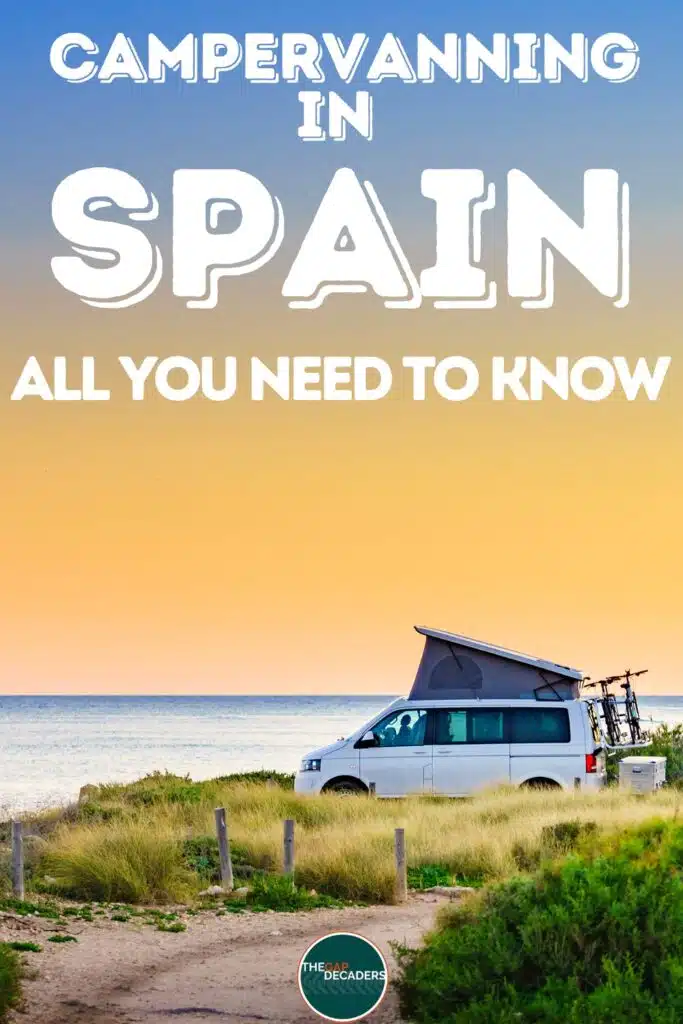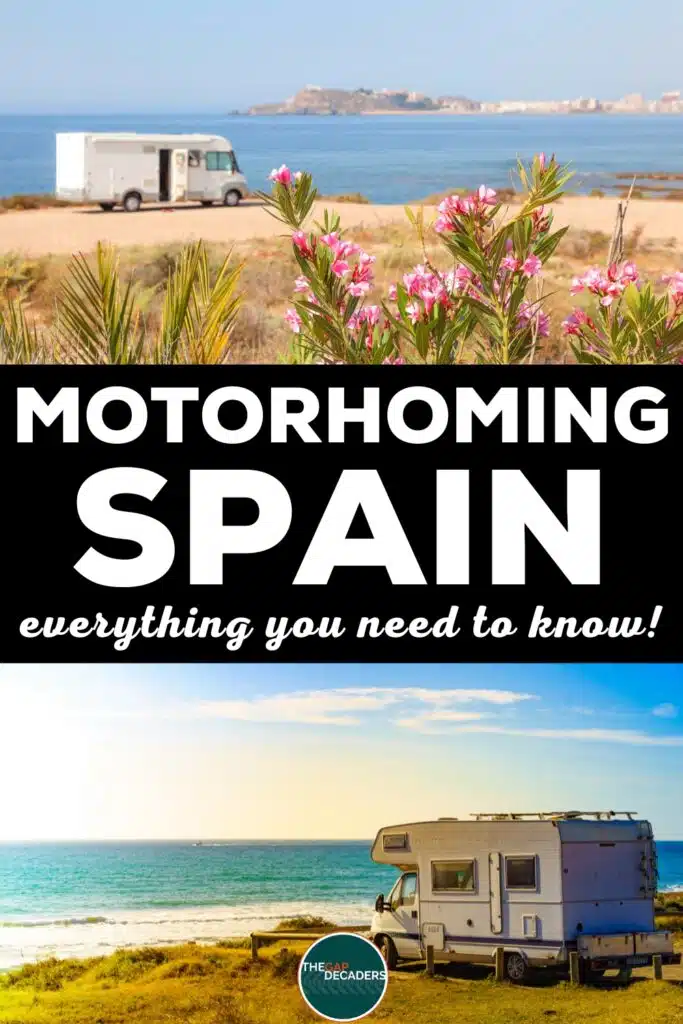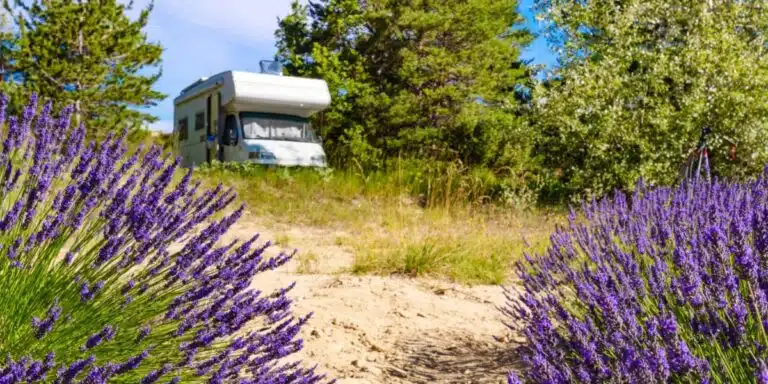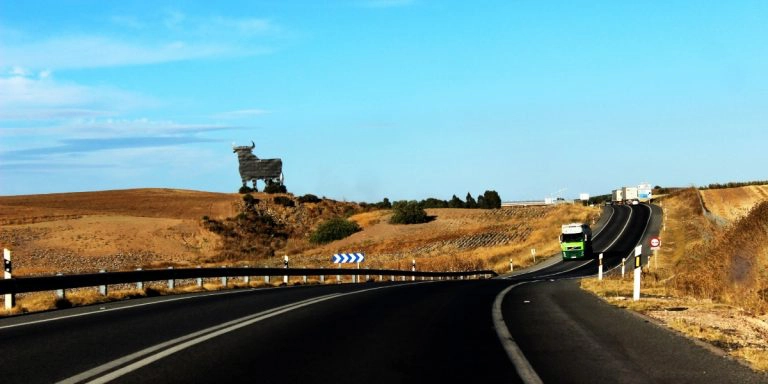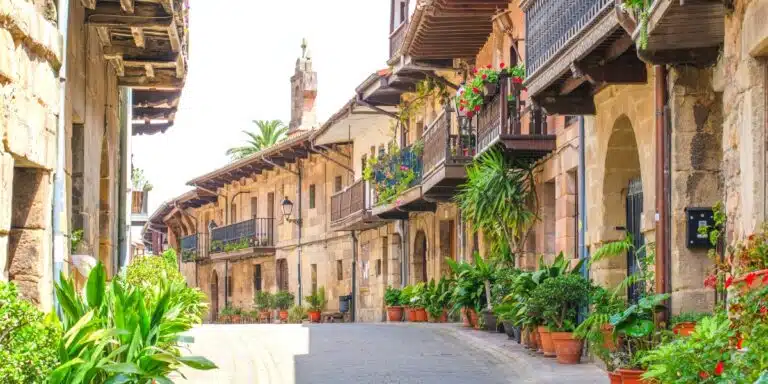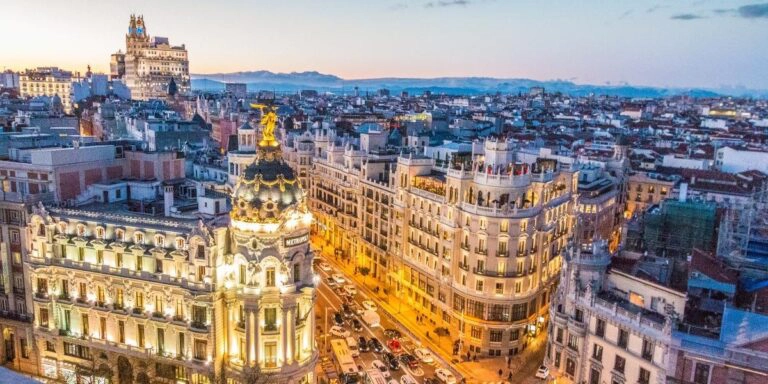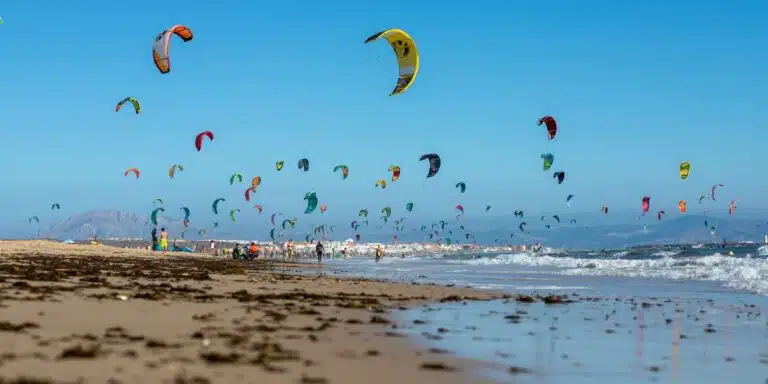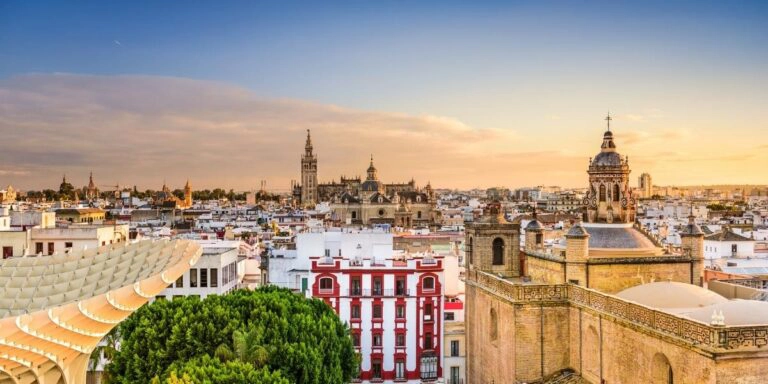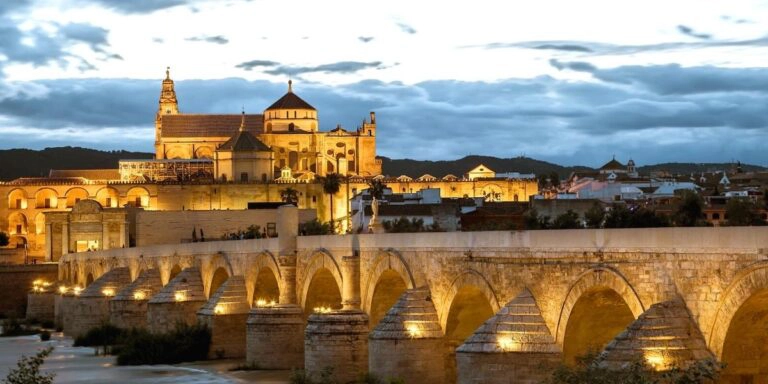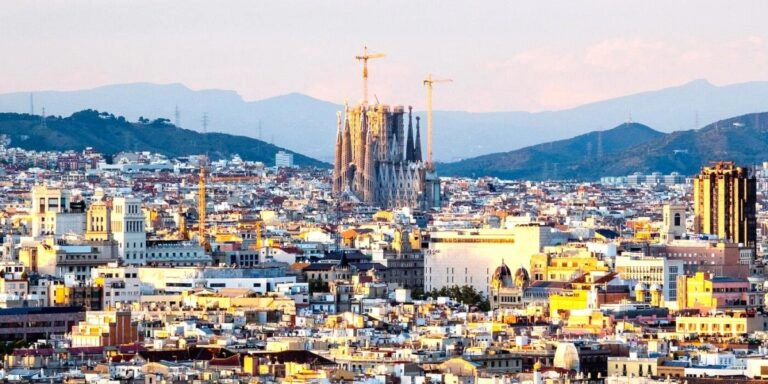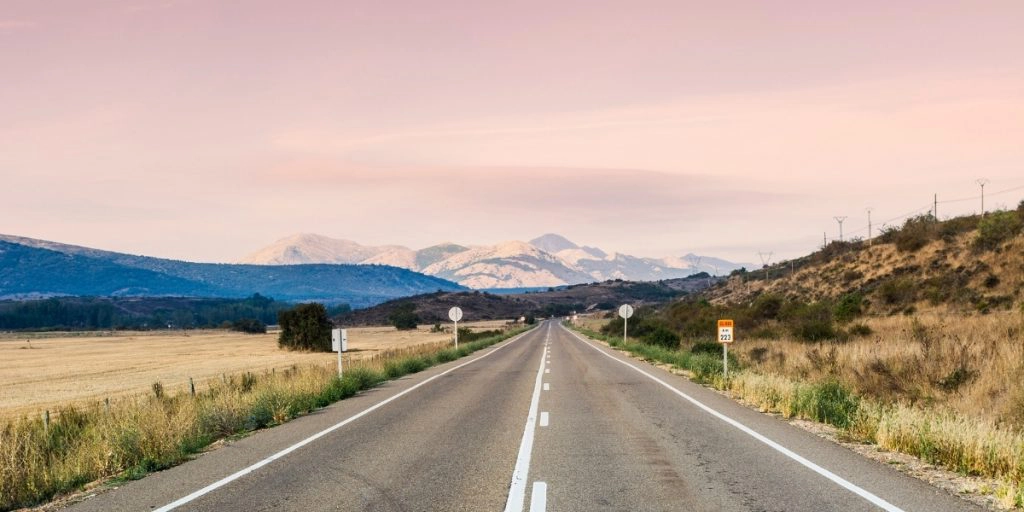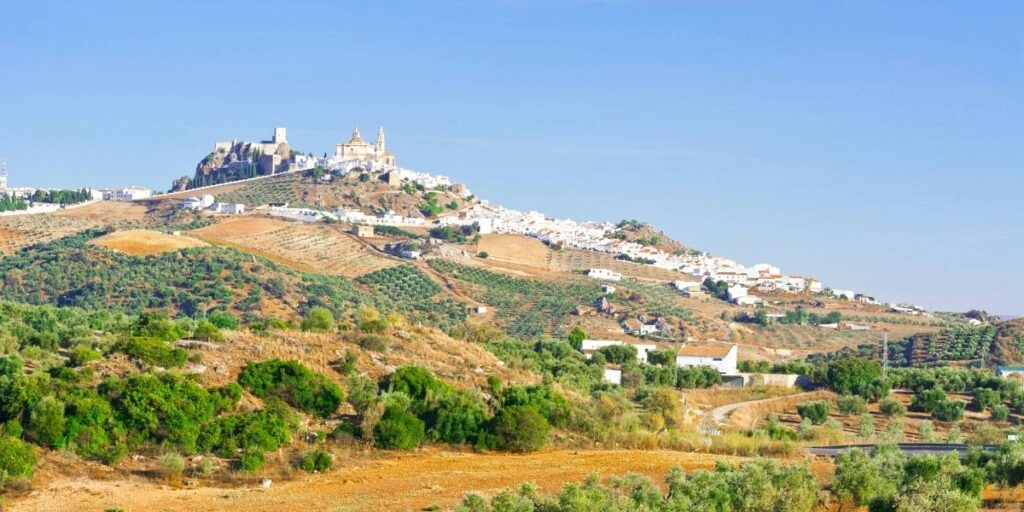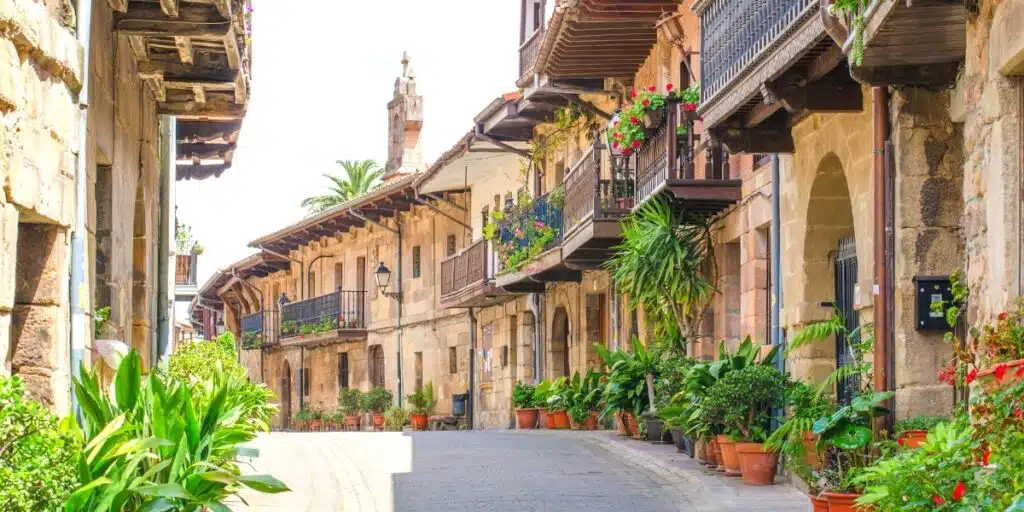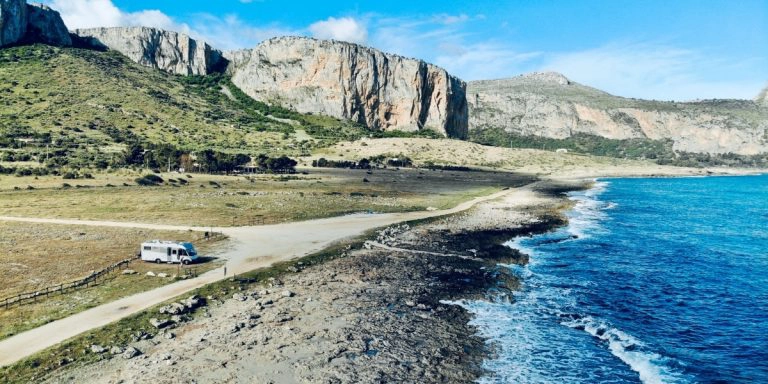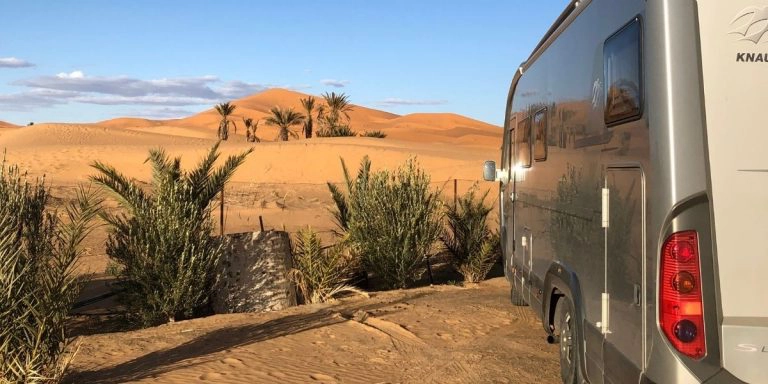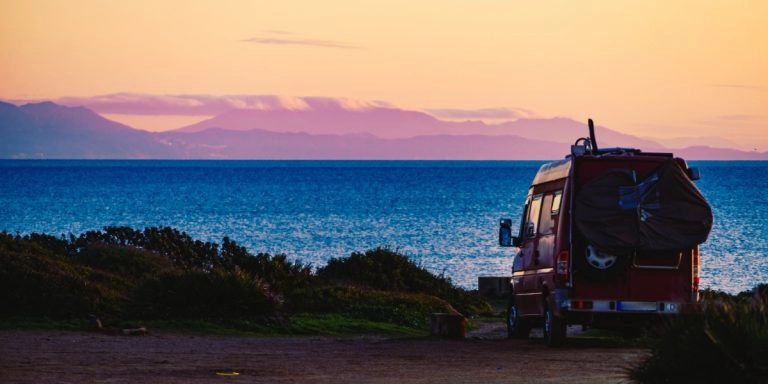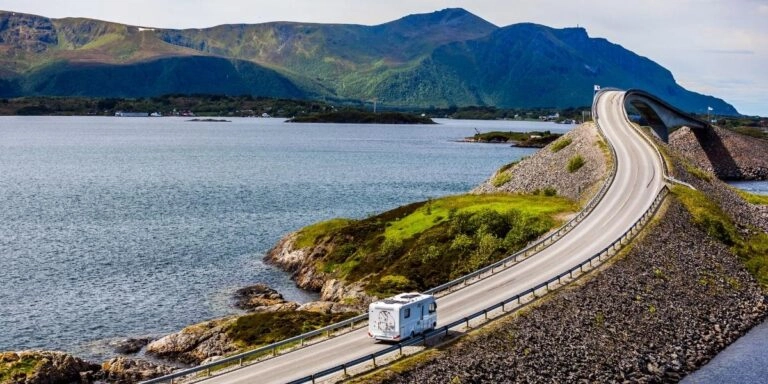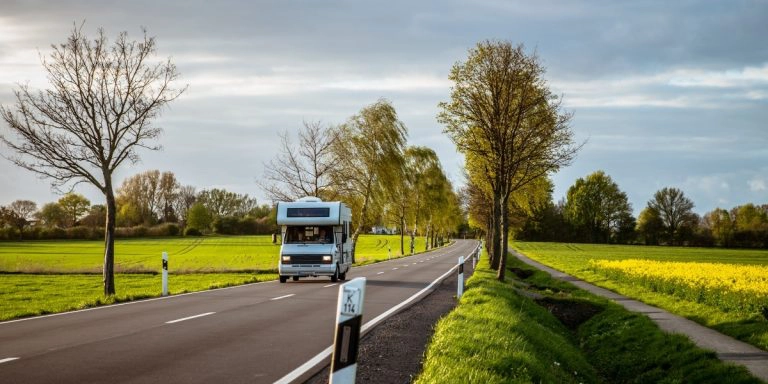This post may contain affiliate links, from which we earn an income. Click here to read our affiliate policy.
Motorhoming & Campervanning in Spain
With one of the best winter climates in Europe, beautiful natural landscapes and friendly locals, Spain is a perfect country for a motorhome road trip. With the colourful traditions, good food and wine and fabulous architecture, you have all the ingredients for an amazing tour.
We’ve spent over 18 months travelling in a motorhome in Spain, and in this campervanning and motorhoming guide you’ll find lots of practical and helpful information. From tips about driving, where to stay overnight and wild camping, to motorhome services and a round-up of the best motorhome destinations, you’ll find all the information you need for an amazing motorhome road trip in Spain.
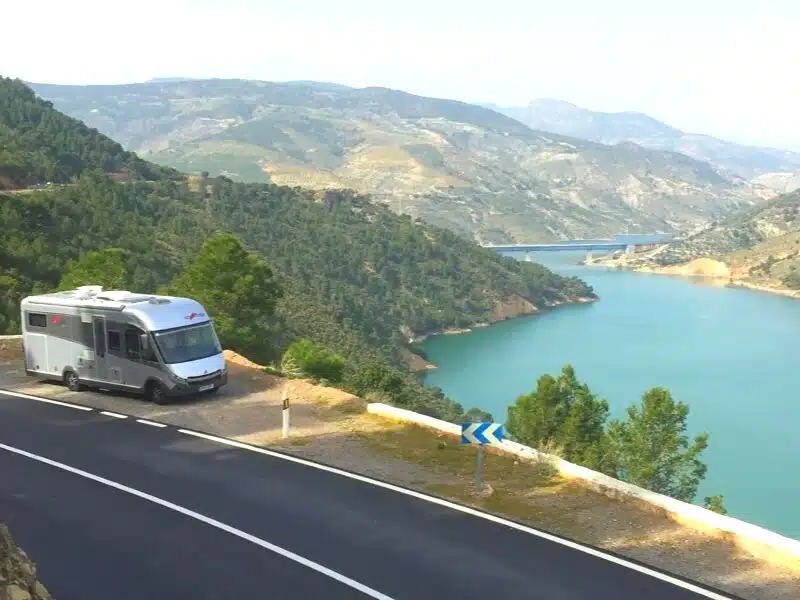
Spain Motorhome Routes
What’s the cheapest way to get to Spain in a motorhome? Do you pay for a long ferry crossing or pay for fuel and tolls doing long miles through expensive France? Your options for driving to Spain from the UK in a motorhome are these;
Sail to Spain from the UK
Sailing from Portsmouth or Plymouth to the northern Spain ports of Santander of Bilbao (depending on which day of the week you want to depart) is the only way to avoid France. This sailing does navigate the Bay of Biscay and can be choppy in autumn and winter, but in our experience, it’s more cost-effective than driving through France.
It’s a long crossing of 32 hours, but does give you the chance to have a proper night’s sleep if you book a cabin. Cabins are not mandatory, but the alternative reclining seats are uncomfortable and noisy.
This is an ideal crossing if time is of the essence, or you’re travelling with a dog (some boats have pet-friendly cabins and some have kennels) but cabins and kennel places do book up quickly.
We recommend you make your booking for the ferry to Spain with Direct Ferries, where you can compare routes and prices to ensure you get the best deal.
Top Tip: Even if you book a standard class cabin, it’s possible to book into the Commodore C-Club lounge, where free hot drinks, water and wine are served, along with generous snacks, meaning you don’t need to pay for expensive food on board.
Is this your first time visiting Spain? Get all our road trip tips in our Spain Travel Guide, including what to pack, the best time of year to go, getting there and practical tips to help you have the best campervan road trip!
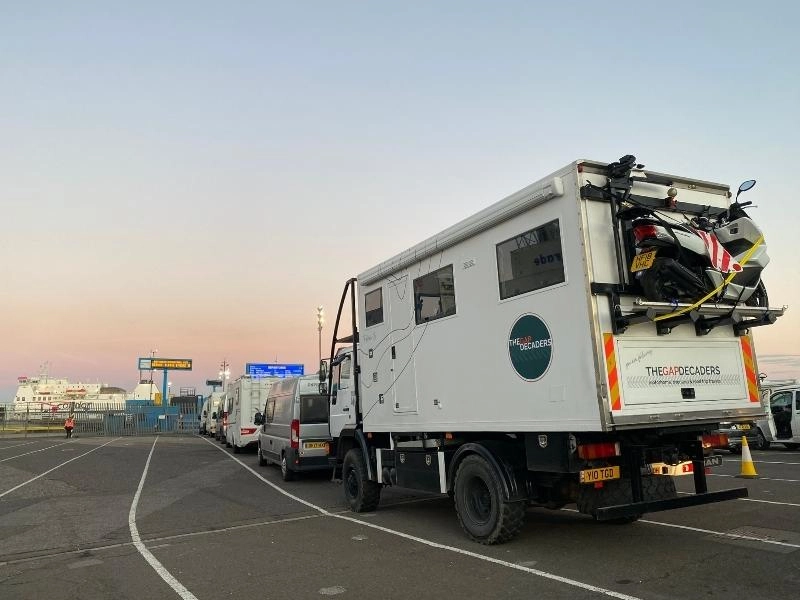
Drive Through France to Spain
Take a road trip to Spain from UK by driving through France. Once in France, head down the west side of the country, via Le Mans, Tours, Poitiers, Bordeaux and Bayonne, crossing the Spanish border at Irun.
This is one of the quickest motorhome routes through France to Spain and is the cheapest from a toll perspective. This route lends itself well to ferries which arrive from the UK in to Caen or Cherbourg.
The driving time from Caen to Irun is around nine hours in a motor home, and tolls will cost somewhere in the region of €170 in tolls, although expect more if you weigh over 3,500kgs.
Or, get to France any way you like and take a slow meander south using non-toll roads and spend some time exploring France as you travel. This is an ideal option if you have plenty of time and are planning a few months or more for your motorhoming in France and Spain trip. Check out our post about driving from the UK to Spain for scenic routes and destination ideas.
Remember if you’re driving across France, you’ll need to observe the French driving laws and road rules, which do differ from the rules in Spain. You can find out more information here.
Motorhoming in France: Your Complete Touring Guide for 2024
Driving to Spain from UK: Best Routes & Driving Tips
Fly & Hire a Motorhome
Campervan & Motorhome Rentals Spain
Flying and hiring a motorhome is the best way to tour Spain if you don’t own one. Our recommended Spain campervan hire company is Indie Campers and they have depots in various places including Madrid, Barcelona, Malaga, Seville and Bilbao – perfect starting points to see all the best bits as you road trip Spain.
Another great campervan rental firm to check out is Activans, who specialize in campervan rental near Barcelona with sports equipment, such as surfboards, kitesurfing gear, windsurfing equipment, bicycles & e-bikes.
For Spain motorhome rental – best if you’re travelling with a family or need more room – check out Motorhome Republic, who have over 40 pick-up and drop-off locations in Spain, meaning you can plan a one-way drop-off, or access the bit of Spain you want to see really easily.
An aggregate motohome and campervan booking site, Motorhome Republic pull together all the best deals from a number of renters, to offer you a wide choice of options alongside an excellent English speaking expert motorhome Concierge Team.
You can also hire a motorhome in the UK and drive it across to Spain. Most hire companies allow their motorhome rentals to be taken overseas, including our recommended hirer, Spaceship Rentals. With a depot in London, top-notch customer service and all the equipment you need for an easy holiday, Spaceship offers the best deals for Europe.
Motorhome Spain & Brexit
Although the UK left the EU at the beginning of 2020, because the pandemic came swiftly on its heels, many of us are still realising the repercussions and getting used to how it affects travelling in a motorhome. You can find out all the details you need in our guide to motorhoming in Europe after Brexit. In the meantime, here are a few frequently asked questions and answers;
Do I need a visa for Europe?
Nothing changes with your passport, but from 2025, the EU will introduce the ETIAS (European Travel Information and Authorisation System), which will be an additional entry requirement for visa-exempt travellers and will involve the traveller registering their details online before travelling, mainly for security purposes.
How long can I stay in Europe?
UK citizens can only stay in the Schengen Area (a zone in Europe where countries have no internal borders and allow the free and unrestricted movement of people) for 90 days in every 180 days in the Schengen Area.
The 90 in 180 day rule works on a rolling basis and it can be difficult to work out whether you are within the rules or not, especially if you have visited the Schengen area on several occasions in the preceding 180 days. Use a Schengen calculator to ensure that you stick to the right number of days and stay within the rules.
What food can I take to Spain in my motorhome?
The European Commission says the following;
Can I use my mobile data in Spain?
It very much depends on who your mobile phone contract is with and when you started the contract. All UK providers now limit data usage in the EU in some way or another, and it’s best to check with your provider to make sure you don’t run up a big bill. You can find lots of information in our guide to the best SIM cards in Europe, especially if you’re planning to be away for more than a few weeks.
We have been using and recommend ConnectPls for cloud SIM connectivity in the UK and Europe. You can choose from unlimited data packs to just single days, depending on your needs. The device is no larger than a slimline smartphone, connects with up to ten devices, is charged easily with a USB and can be delivered within a few days of ordering. Use the code ‘thegapdecaders’ at checkout to get 50% off in the first month!
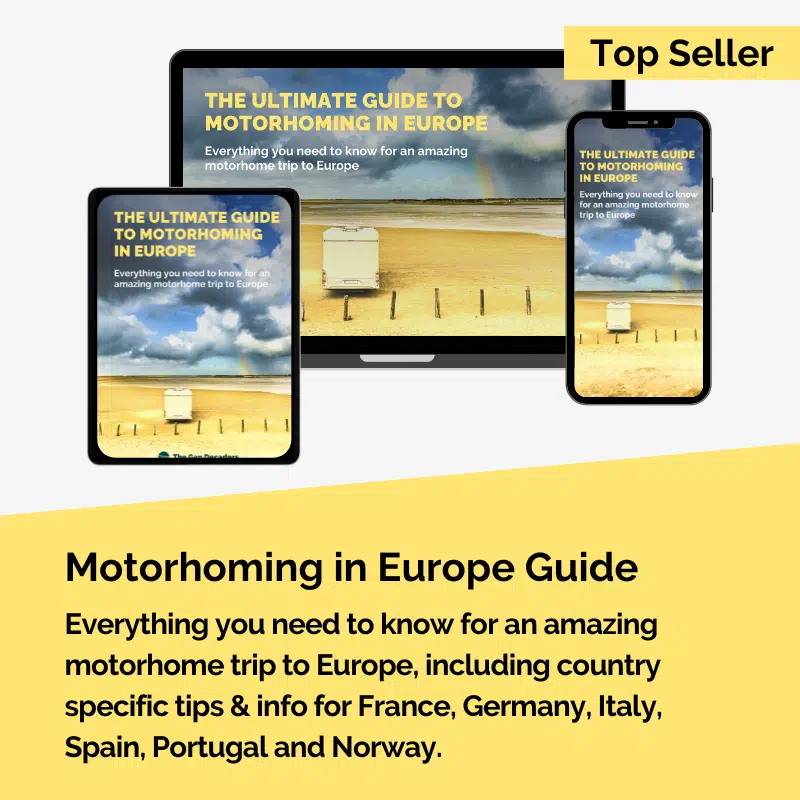
The Ultimate Guide to Motorhoming in Europe
If you’re planning a motorhome trip to Europe for the first time, our guide has tips, advice and info to help you plan your tour.
Don’t struggle trying to plan your European trip, find out everything you need to know before you go + loads of motorhoming tips for when you arrive.
Can I take a pet to Spain in my motorhome?
Yes, you can take dogs, cats and ferrets to Spain. You’ll need to book a pet-friendly cabin or kennels on the ferry or travel via the tunnel. Your pet will need a microchip, a valid rabies vaccination and an animal health certificate (AHC).
It can take some time to get all the documents together and the vaccines organised, so make sure you start the process well in advance. You can find out more about travelling with pets on the Gov.UK website.
More motorhoming in Spain travel advice and guides;
When to Visit Spain in a Motorhome
Spring and autumn are wonderful times for a Spanish road trip – from March until June will get you wildflowers and near-perfect temperatures, warm enough to swim in the sea from May onwards from the Costa Blanca south, and only a light top needed in the evenings.
In the high season of summer it can be blisteringly hot and wild camping can be a challenge without air conditioning.
September and October offer warm sunshine, with the earth and sea still warm from the heat of August.
Motorhoming in Spain in the winter months offers many benefits but be prepared as you may need to use your heating and will find it cools down as soon as the sun sets. Inland and in the Spanish mountains, nights can be chilly and in the north, you may well see snow.
The Spanish Costas can feel crowded with touring motorhomes over winter, as Northern Europeans seek a milder climate. For a more authentic Spain, head to inland rural areas away from the Costas and enjoy everything the mountains and gorgeous interior cities and small towns have to offer.
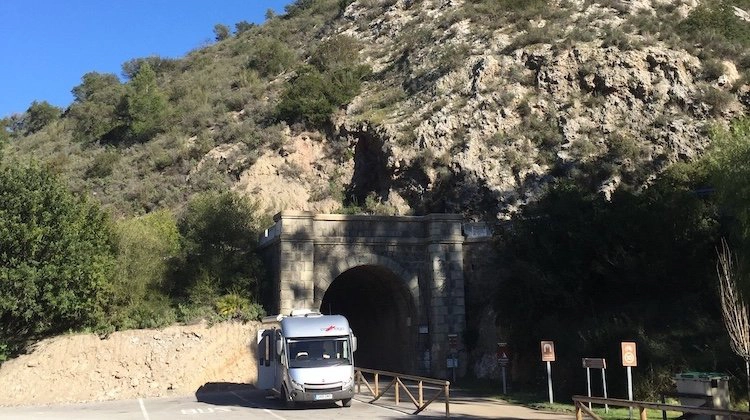
Driving a Motorhome in Spain
Spanish roads are typically well-maintained, and the drivers are considerate and relaxed.
In the interior of Spain in your motorhome, you may well have long stretches of sweeping Autopista (motorway) and autovía (dual carriageway) to yourself. The trade-off is the Costas where traffic ramps up and tailbacks are frequent.
Driving around Spain in a campervan is generally safe and easy, but be mindful of smaller towns without by-passes if you’re in a longer vehicle.
You may want to consider a sat nav or satellite navigation app which can be configured to your motorhome camper size and weight.
Spanish Speed Limits for Motorhomes
Always observe the speed limits when campervanning in Europe. There are speed cameras just as in the UK, and the Spanish (and other EU) authorities have been known to pursue Brits for non-payment of fines. This has not changed since Brexit as the information-sharing agreement with the DVLA continues.
Motorhomes < 3,500 kg (also relevant for those touring Spain by car or campervan)
Motorhomes > 3,500 kg
Documents You Need to Travel & Drive in Spain
Make sure you have travel insurance you can trust when motorhoming Spain. We recommend True Traveller for their 5-star TrustPilot reviews, variety of cover options, best activities cover as standard, great prices and excellent service.
Vehicle Safety Equipment in Spain
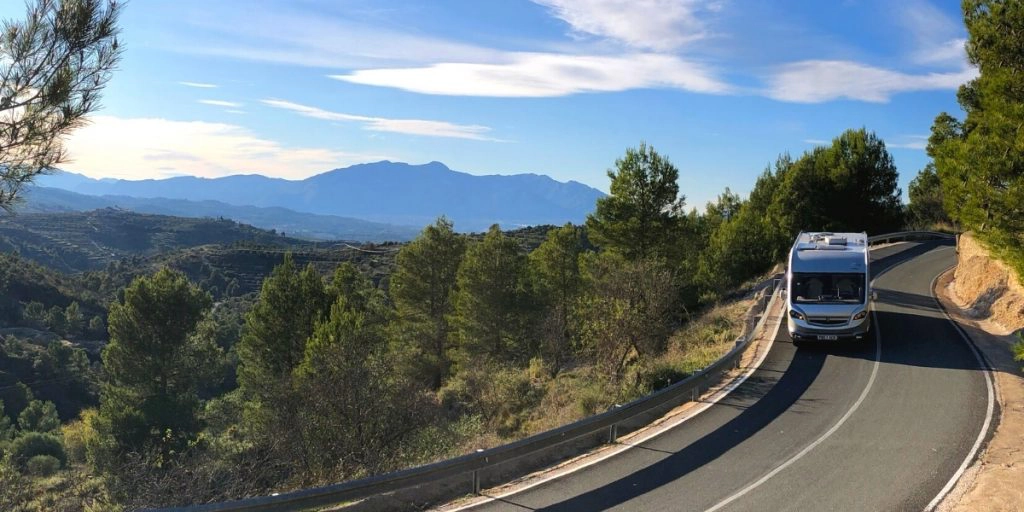
Driving a Motorhome in Spain Tips
Toll Roads in Spain
Spanish toll roads are pay-as-you-go and are very reasonably priced. You can pay with cash or credit card, or with an electronic tag system like Emovis, which also covers you in France and Portugal.
Due to the huge swathes of nothingness in the interior, tolls are definitely worth taking if you are trekking from one side of Spain to the other in your motorhome.
In January 2020 and September 2021, many tolls were removed, even for large motorhomes. The AP7 on the Costa Blanca and Costa del Sol retains some charges, but they are minimal and are no longer decided by the weight of your vehicle, making them even better value for motorhomes.
RELATED POST: Tolls for Heavy Motorhomes >3.5T in Europe: Country by Country Guide
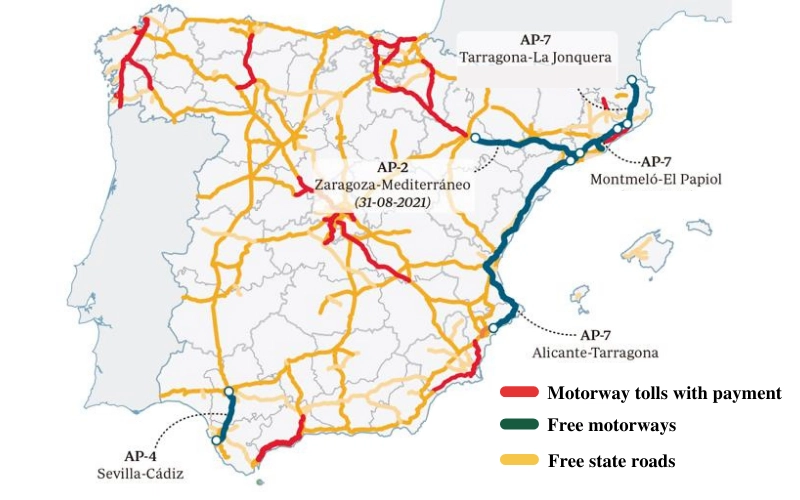
Low Emission Zones in Spain
At the end of 2023, there are 16 low emission zones in Spain.
Due to the Climate Change and Energy Transition Law, Spanish municipalities with over 50,000 residents have to implement such zones by the end of 2023. However, the definition of a Zona de Bajas Emisiones or Low Emission Zone, in the Spanish legislation is quite vague.
Cities may also undertake access regulations that are not defined by motor vehicle emissions standard, but instead reduce traffic and therefore emissions. They can also implement policies to have that same goal, without any access restriction zone.
Spanish plated vehicles will be registered and receive an LEZ sticker, but currently, foreign vehicles can’t buy stickers although they have to meet the required standards.
If you are stopped, you may be able to evidence you meet the standards with your V5C, Certificate of Conformity or LEZ sticker from another country.
The only exception is in Barcelona, where you will need to register your vehicle in order to drive within the LEZ here.
Motorhome & Campervan Services in Spain
Motorhome services are generally widely available, especially along the coast. Some garages and supermarkets will have fresh water and a place for grey water.
You’ll often see the typical pictogram sign by the side of the road pointing you to a service point, this may be a dedicated area, within an aire or another facility.
The types of built-in Flot Blu services like you find in France are few and far between. Use an app like Park4Night to locate motorhome and campervan services.
Motorhome LPG & Gas Bottles in Spain
LPG for refillable systems is available in many garages, use the myLPG app to search near where you are. In Spain, as in most of Europe, LPG is known as GPL, and both are a mix of butane and propane.
In Spain, LPG is grade C, which means the percentage mix of propane to butane is approximately 30/70. Between 1st November and 31st March every year, the mix changes to 35/65 to account for the colder weather.
You may find that if you’re in the mountains in winter, this mix causes your boiler to sound like a freight train unless you have a specific altitude setting which some models of Alde boiler have as an extra. You can find out more information here.
Gas bottles are also widely available, with butane generally being more popular because of the warmer climate (butane is more suited to milder weather conditions but propane is better for cold weather as it burns at lower temperatures).
The Spanish government caps the price of gas, and you should expect to pay around €15-18 for a replacement bottle. For Spanish gas bottles, you will need a different regulator, available from most DIY or camping shops.
Gas in bottles and at the pump is much cheaper in Spain than in France or Portugal (in fact, people often drive their motorhomes from Portugal to fill up!).
Motorhome Fuel in Spain
Most petrol stations will require you to pay electronically for fuel at the pump. Usually, you can adjust the instructions to English. The pump colours are green for petrol and black for diesel.
Sin Plomo 95 is Regular Unleaded, Sin Plomo 98 is Premium Unleaded and Gasoleo (sometimes called Gasoil A) is Diesel – and sometimes it’s also called diesel in Spain.
Gasoleo B or Gasoil B is the equivalent of red diesel for agricultural vehicles – do not put this in your motorhome!
Diesel in Spain is some of the cheapest in Europe, especially if you fill up at the supermarket, with Cepsa and Repsol garages being the most expensive.
Motorhoming in Spain FAQs
Can you park a motorhome anywhere in Spain?
You can park a motorhome or campervan on the street or in a car park provided there is no sign prohibiting this. Remember that ‘parking’ is different to ‘camping’ though, and if you’re free camping in Spain where signage forbids it, you are likely to be fined and moved on, especially if you’re on the coast.
Is Spain campervan friendly?
Yes, Spain is very campervan friendly. The country is well used to snowbirds flocking there in winter in search of the sun, and many facilities for motorhomes and campervans remain open year-round. We have seen an increase in recent years of signage forbidding vans camping and parking, especially along the coasts, but there are still plenty of places to choose from.
What is the best route to Spain in a motorhome?
For us, the best motorhome route to Spain from UK is by boat from Portsmouth to Santander because French toll roads are expensive. But, if you have time, taking a slow meander through France on toll-free roads and making the route a part of your holiday is a better way to get to Spain.
What do I need to drive motorhome in Spain?
You must have a valid driving license in your home country and your motorhome must be legal in the country of registration. If you’re motorhoming in Spain from UK, this means your van must be insured (minimum 3rd party), taxed and have a valid MOT.
Are there campsites in Spain?
Yes! All across the country you’ll find great motorhome campsites. From large campsites with pools, modern sanitary facilities and beachside locations to small rural sites in the interior, Spain has a campsite to suit every type of motorhomer!
Motorhome Stopovers in Spain
Motorhome Aires
Motorhome aires in Spain are not as plentiful as in France but they are out there! As in France, sometimes there is a fee per night but often there is no charge and basic services are provided.
Bear in mind that you are more likely to find Spanish camping aires inland than on the coast. You can read more about aires, how to find them and road trip planning here.
You cannot book aires for camping in Spain, it is advisable in the holidays and in popular places to try and get there early in the morning or just after lunchtime.
If you arrive at 6pm expecting a place, then you will probably be disappointed. Always have a second choice in reserve, one of the best resources to use is All the Aires Spain and Portugal.
RELATED POST: Motorhome Aires in Spain – All You Need to Know
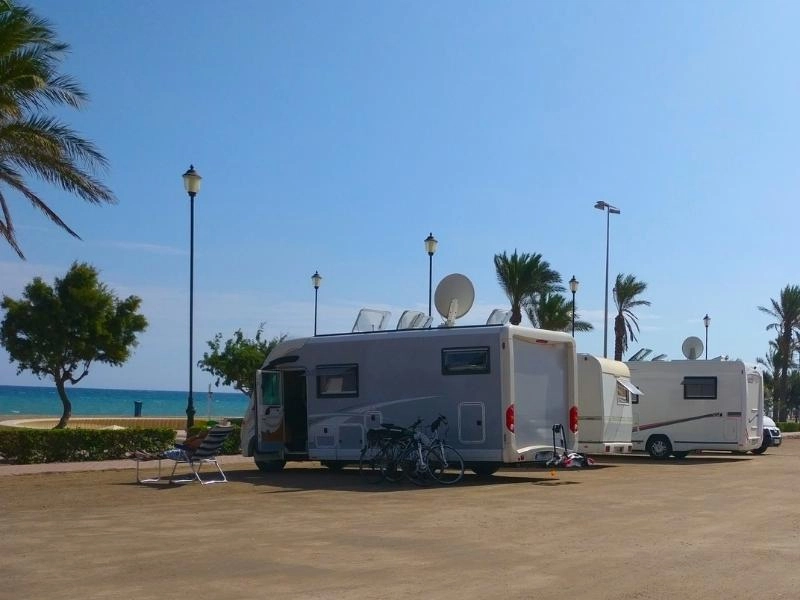
Campsites in Spain for Motorhomes
Spanish campsites range from very basic camping spots in off the beaten path tourist areas to full-on touring stops where people book motorhome pitches up for six months and enjoy entertainment every night, direct access to a sandy beach, three different bars and a covered and heated pool.
Whichever is your bag (and there is a lot of choice), if you’re heading south in your camper in Spain for several months of the winter and a long site stay, make sure you book in advance! Book with Eurocampings for the best deals on over 520 campsites in Spain.
For more information about over-wintering, check out our post about whether you should take your motorhome to Spain for winter.
In the southeast of the country, water is in very short supply. Many camping sites will provide desalinated water instead of potable water.
In the short term, this is fine but you may want to clean out your fresh water tank with a high-pressure hose once you have moved away from this part of Spain due to the sediment found in desalinated water.
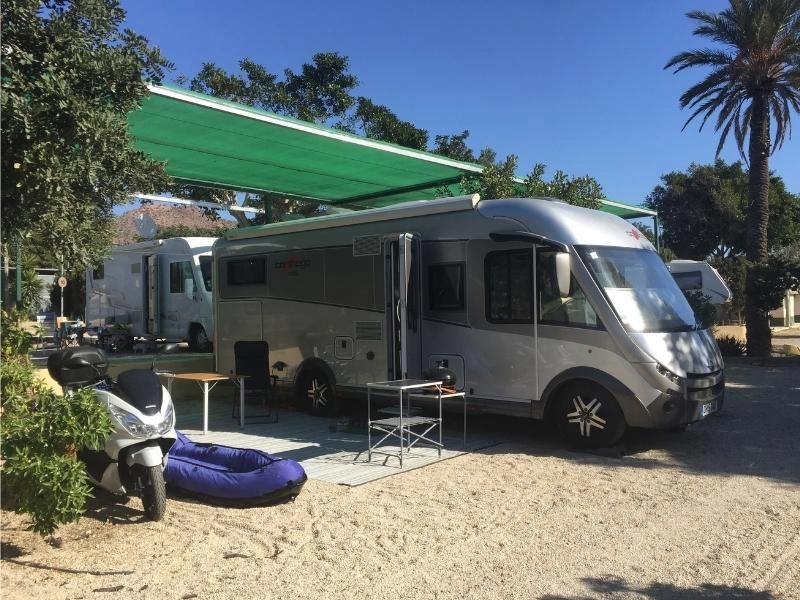
Do I need an ACSI card?
In Spain, your ACSI CampingCard will come into its own if you’re planning on touring and stopping for less than seven nights at sites. Out of season, you can get over 60% discount on ACSI sites.
If you are staying longer, then it is likely that the site’s own rate will be better value – the longer you stay the cheaper it becomes. If you are stopping for over 30 nights it is possible to stay at a good quality site for €10 a night including electricity.
Some larger sites or those run by corporates will have a fixed number of ACSI pitches which will have EHU but no water or drainage.
They will probably be smaller than other pitches and perhaps not as favourably placed. If you want a different pitch, you will be charged a supplement which often wipes out the benefit of the ACSI card, so pick smaller sites for the best experience.
Wild Camping in Spain for Motorhomes
Wild camping for motorhomes in Spain (sometimes called free camping or wild parking) is generally tolerated away from busy beaches, towns and cities, and outside of national parks and and coastal regions.
Free motorhome parking in Spain is easy and safe as long as you follow a few basic guidelines. Make sure your wild camping spot is not on private property and that you have parked respectfully of residents and other wild campers nearby.
The main thing to know about wild camping in Spain is that you must not display any signs of ‘camping’, such as leaving chairs out or having your step out when you go to bed. Thus you are ‘parking’ not ‘camping’ which is allowed and considered a legal activity, even if you intend on sleeping in your van. The infographic below explains the difference.
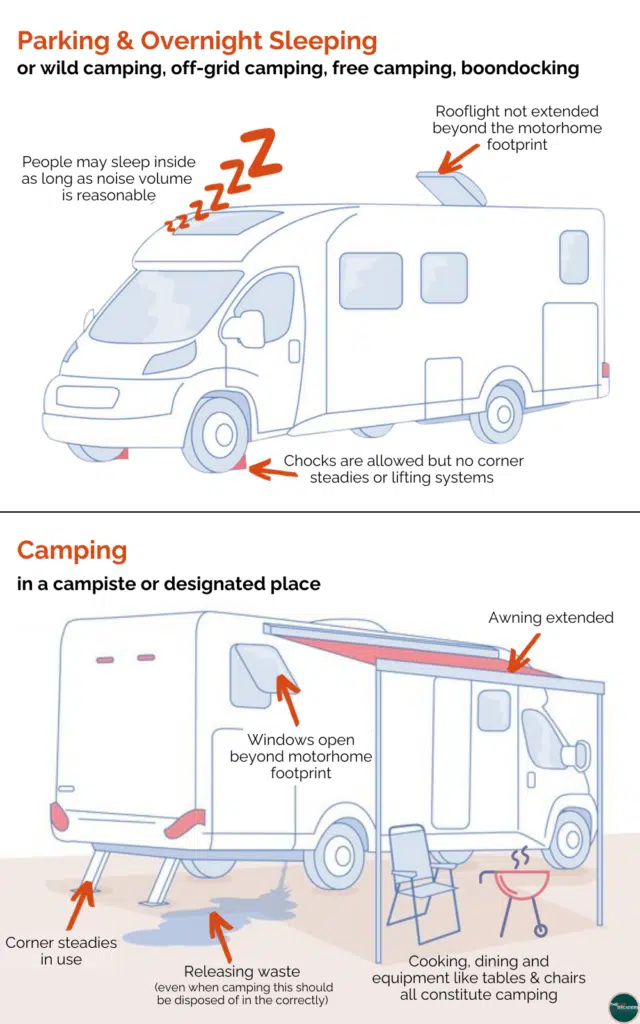
Before motorhome overnight parking, do your usual checks and add an extra one. Look for Pine Processionary Caterpillars when in Spain, which make their nests in those lovely shady pine trees we all like to park under. These caterpillars can kill dogs and small children, and will most definitely spoil your motorhome trip if you bump into one!
Use Camper Contact and Park4Night to find the best wild camping spots for motorhomes and campervans in Spain.
Motorhome wild camping in the Valencia Community is no longer permitted. The Valencia region passed a new law which came into effect on 8th May 2021, which prohibits motorhomes from parking or camping, unless in designated areas. The new decree aims to level the rules whether you’re in a motorhome or tent but there is some acknowledged ambiguity around the wording, you can find out more in this article.
RELATED POST: Motorhome Wild Camping – Your Complete Guide
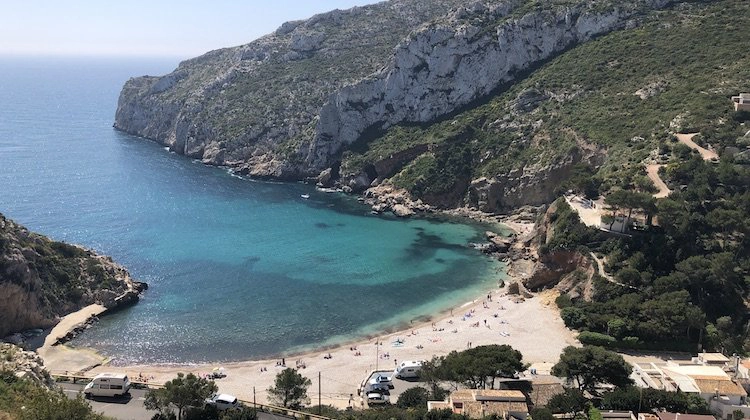
España Discovery
A similar scheme to France Passion, Espana Discovery provides motorhomers with stopovers at over 206 off-the-beaten-path farms, bodegas (vineyards) and producers.
Buy the guide online and get full access to 24-hour stays. There is no obligation to buy any produce, but our experience when we have bought has been really positive.
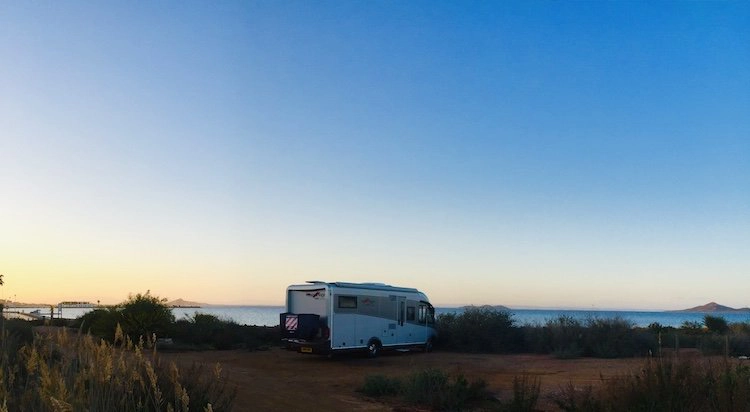
Spain Travel Books
Top Motorhome Destinations in Spain
The Pyrenees
The Spanish Pyrenees are absolutely stunning. Look out for Ainsa, a beautiful medieval hilltop town in Aragón, with incredible mountain views.
If you like to hike, head for the Ordesa y Monte Perdido National Park, to hike the famous Circo de Soaso. This is one of our favourite Spanish national parks, for its dramatic landscape and fantastic hiking.
The Pyrenees is best visited between May and October, unless you want to ski, as outside these times you will definitely encounter snow.
RELATED POST: A Seven Day Pyrenees Hiking Tour
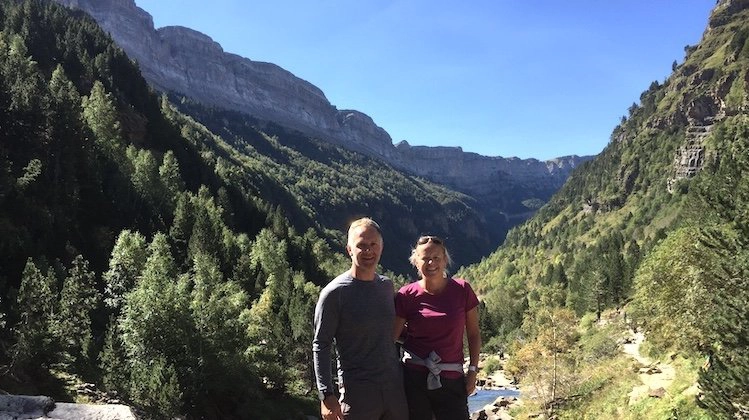
Picos de Europa
Halfway between San Sebastian and Santiago de Compostela, the Picos are a miniature masterpiece. 40km across and wedged between three great river gorges, the Picos’ snowy mountains are a natural paradise.
The Peaks of Europe, so called because they were the first landmark to be seen by sailors of old on approaching the continent, are well worth a visit. There is a lot of diverse hiking here but the weather can be unstable and the terrain unforgiving.
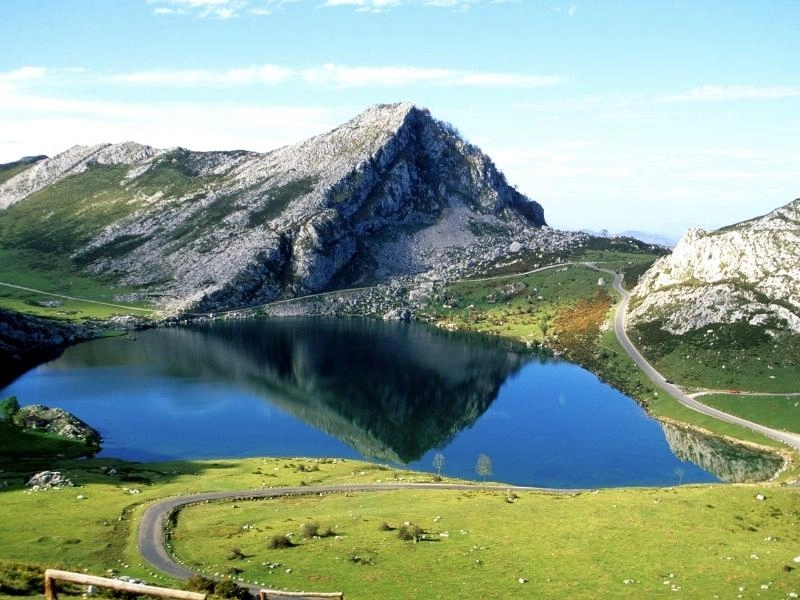
León
A prosperous and cosmopolitan city with a great vibe. The aire here is on the banks of the river Bernesga, which affords some good running routes along level paths. You will also be within easy walking distance of the Casco Antiguo, the old town.
Wander here for a day and see the cathedral, Plaza’s Mayor and Santa Domingo and the Basilica de San Isidoro. All that walking demands you sample the tapas scene, arguably the best in Spain, with regular live music and tapas that are a bit more inventive than the normal tourist offering.
Order a Cerveza pequeña (small beer) for €1 and get a free tapa, you can do this in all the bars in León and literally have your dinner for nothing!
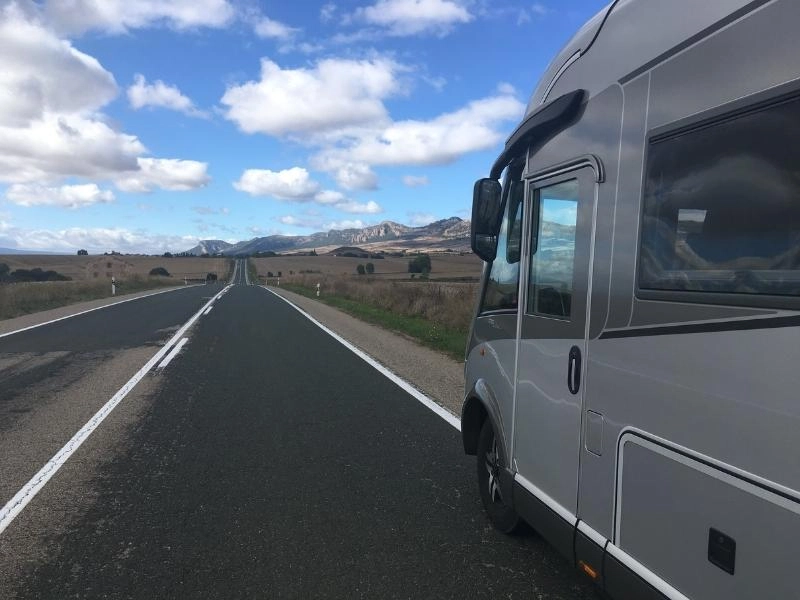
Santiago de Compostela
This corner of Spain, including Galicia, is known as Green Spain because it rains so much! It’s probably best visited in Spring or September/October on your way to sunnier climes. Stay at Camping As Cancelas for easy access by bike or foot into the historic centre.
Santiago de Compostela is a stunningly beautiful city full of twisting alleys, elegant squares and historic religious buildings, with interesting nooks and crannies everywhere.
The medieval centre of Santiago de Compostela is almost entirely pedestrianised, in keeping with its UNESCO World Heritage status. If you only see one thing, it must be the Cathedral, where all roads seemingly lead, including the famous Camino.
North Spain Road Trip: Itinerary, Route & Tips
Madrid
The beautiful capital city of Spain has to be visited. Packed with great museums and atmospheric squares and quarters, Madrid is a great city in which to spend a day or so.
We stopped at Camping Osuna in the east of the city, close to the airport. At €35 a night, this is without doubt, the poorest value-for-money motorhome campsite site we have ever stayed on, although our research suggests it’s the best motorhome site in Madrid!
However, in common with most cities, the choice of where to stay in a motorhome is not great. The roads within the site are deteriorating badly and the showers and sanitary facilities are poorly designed (although clean and with plentiful hot water) but this is all surmountable if you want to see Madrid!
What this site does have though, is great access to the Metro. The nearest metro station is Canillejas, about a ten minute walk and on the same line as all the major tourist destination stops, so no changes are required.
Reception at the campsite will give you more information about the Metro and explain the different types of tickets.
Madrid in One Day: The Best Itinerary, Map, Tips & Guide
Huelva
Visit La Rábida to see the amazing full-scale models of the three ships in which Columbus and his crew sailed across the Atlantic to discover the New World. We stood looking at these tiny vessels in awe of the courage and belief it must have taken to start that famous voyage.
We parked our motorhome for the night in one of the parking areas in La Rábida, where you can see life-sized replicas of the ships Christopher Columbus sailed across the Atlantic for the New World (and they are tiny) from Huelva and the Monasterio de Santa María de la Rábida, where the explorer met Queen Isabella of Spain to persuade her to fund the venture and stayed as he prepared for the trip.
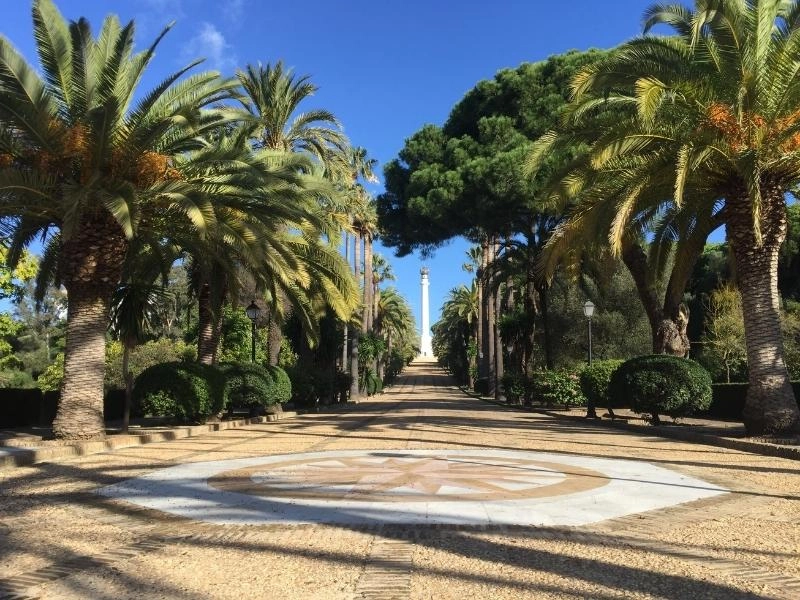
Costa de la Luz
The sea city of Cadiz, between the Donana National Park and Tarifa, makes a wonderful base and enjoys the most hours of sunshine in Spain. Make sure to explore the local area aptly named the Costa de la Luz, or Coast of Light, which extends south to Tarifa, right in the south of Spain.
Off the beaten path on the Costa de la Luz are the beautiful beaches of the Atlantic Ocean which are dotted with chiringuitos serving locally caught fish and pretty white villages like Vejer de la Frontera, quietly unassuming yet packed with history and architectural gems.
The fabulous Cape Trafalgar, the site of the 1805 naval Battle of Trafalgar, in which the British Royal Navy commanded by Admiral Horatio Nelson decisively defeated Napoleon’s combined Spanish and French fleet, is well worth a visit.
To the north is the curious village of El Rocío, famous for it’s dusty car-free streets where horses reign and the Romería de El Rocío, a procession and pilgrimage that takes place on the second day of Pentecost in honor of the Virgin of El Rocío.
Cadiz is also a good base for wine lovers to explore the fabled sherry triangle, which has the cities of Jerez de la Frontera, Sanlúcar de Barrameda, and El Puerto de Santa María at the points of the triangle.
The bodegas where sherry the wine is blended and stored are all located within these cities. We found El Puerto de Santa María a good option as there is a good motorhome site there by the beach, easy access to the bodegas of the town and a convenient ferry to Cadiz.
RELATED POST: Fall in Love with Spain: 20 of Our Favorite Things to See & Do
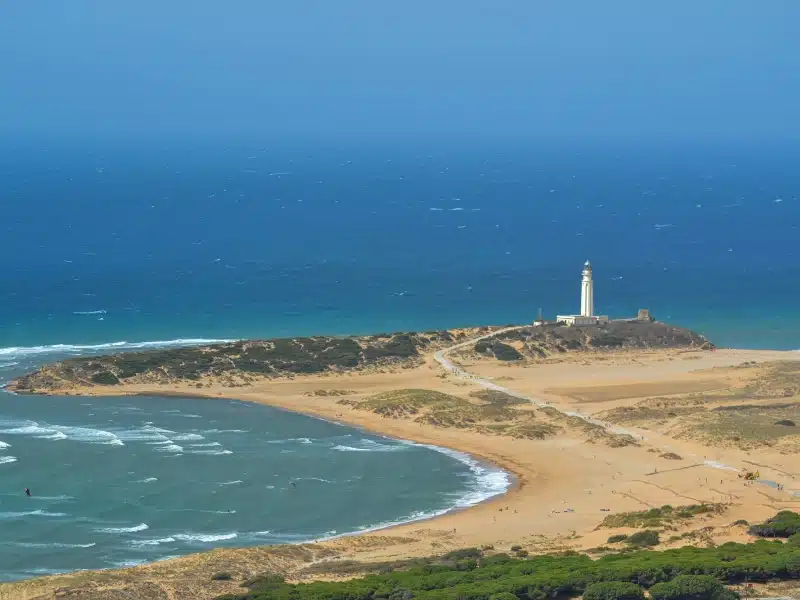
Tarifa
The most southern point of mainland Europe, we loved Tarifa with its laid-back surfer dude feel, sandy beaches and abundant opportunities for activity. So much so that we spent a month there in Camping Valdevaqueros, beating the ACSI price with a long stay deal.
We found some of the best hiking in Spain here and were able to kite-surf, cycle and run, all in the balmy winter temperatures that southern Spain is known for, and hop on the ferry across the Strait of Gibraltar for an overnight trip to Tangier.
Tarifa Guide: Best Things to Do + Top Visitor Tips
Seville
Your next stop should be Seville – you will fall in love with this captivating and romantic city. Spend a few days wandering the old town and narrow streets of Barrio Santa Cruz; admire the architecture and enjoy the typical Spanish ambience.
There are a number of must-sees in the city centre including the Plaza de España, the Real Alcázar, the Giralda Tower and the Cathedral. We stayed at the Port of Gelves just outside the city but accessible by scooter or public transport.
One Day in Seville: Itinerary, Map, Tips & Guide
Via Verdes
All across Spain, you will find a network of Vias Verdes – literally translated as ‘greenways’. They are old, disused railway lines that have been converted to cycling and walking tracks, often through stunning scenery with few other users. You’ll often find a Via Verde in close proximity to an aire or off-grid parking spot, like the free camping in the parking lot at Coripe for the Via Verde de la Sierra, a really stunning ride.
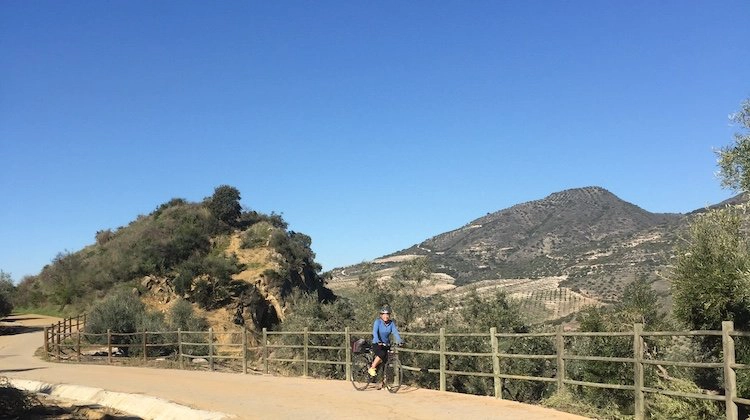
Córdoba
Another beautiful city to fall in love with! Córdoba is full of Moorish treasures. The most famous of these is the Mezquita; the grandest and most beautiful mosque ever built by the Moors which is now a stunning Cathedral. The whole of the historic centre of Cordoba is a UNESCO World Heritage Site, and it’s the perfect spot to spend a day meandering and admiring.
We parked and stayed at the Municipal Camping Car Parking (1 Av. del Corregidor). This is designated motorhome parking, well-lit and manned with CCTV and services but no EHU. Not all spaces are level and the majority were originally designed for cars so have kerbs in what is now the middle of the space!
When visiting Córdoba in a motorhome, this is the only designated parking allowing overnight stays; we found it to be great value for money, with security being important.
You are literally over the road from the old town and within 5 minutes, you will be at the Mezquita.
Cordoba in One Day: Itinerary, Map, Tips & Guide
Ronda & Grazalema
From here, drive south towards Ronda and the Parque Natural de la Sierra Grazalema. This dramatic and wild space is iconic Andalusia; it seems like every hillside cradles a Pueblo Blanco.
Ronda is surrounded by mountains and is split in half by the gaping gorge of the river Tajo. This gorge is spanned spectacularly by an 18th century arched bridge and tall houses perch precariously along its edges.
Head to Zahara de la Sierra and follow the spectacular CA-9104 road to Grazalema, which climbs to the Puerto de Las Palomas (Pass of the Pigeons), at 1180m it’s a spectacular drive and worth the fuel to get there – this is what motorhoming in southern Spain is all about!
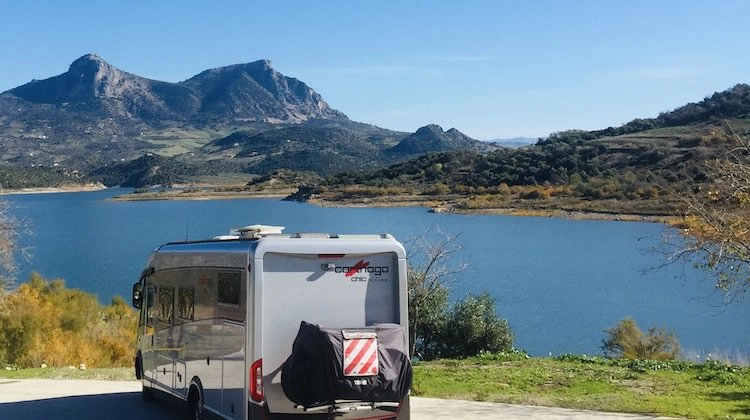
Caminito del Rey
Further to the east, you’ll find El Chorro and the famous Caminito del Rey, one of the most dangerous hikes in the world until the H&S experts got hold of it!
Further to the east, you’ll find El Chorro and the famous Caminito del Rey, one of the most dangerous hikes in the world until the H&S experts got hold of it!
Not only is this a noteworthy hike along the route of the river Guadalhorce it is also an area of outstanding natural beauty worth exploring further. Book this hike well in advance, even outside of peak season, and go with a guide. For an extra few euros, you will learn so much.
We stayed several nights at this great riverside spot, perfect for getting the bus to the start of the hike and then walking back from the end, via the bar of course!
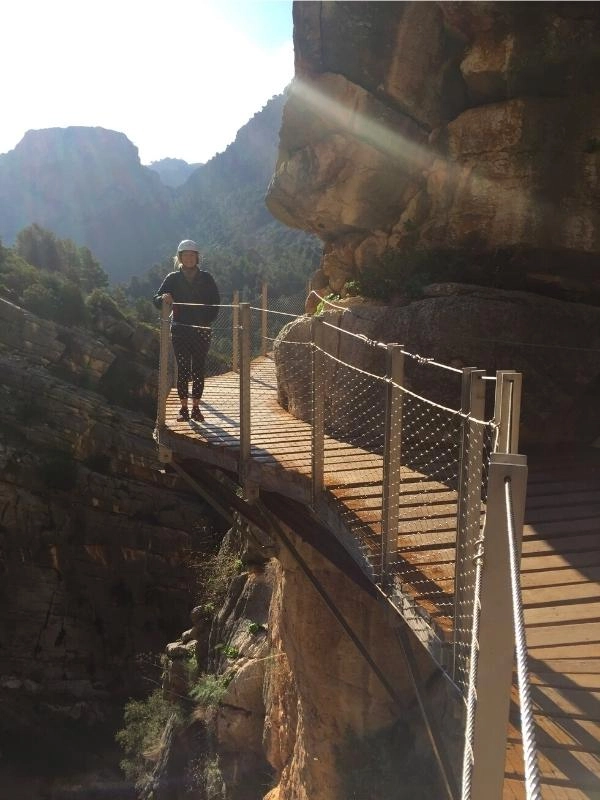
Sierra Nevada
The mighty Sierra Nevada mountain range is home to the highest point of continental Spain and the third highest in Europe after the Caucasus Mountains and the Alps; Mulhacén peaks at 3,479m above sea level.
Take the mountain roads to the romantic city of Granada the romantic city of Granada, and the whitewashed villages of the High Alpujarras, Pampaneira and Trevélez, the highest village in Spain.
In both Pampaneira and Trevélez, we were the only motorhome in their car park, here and here respectively. Although this was in late February, we found all the bars and restaurants open and welcoming.
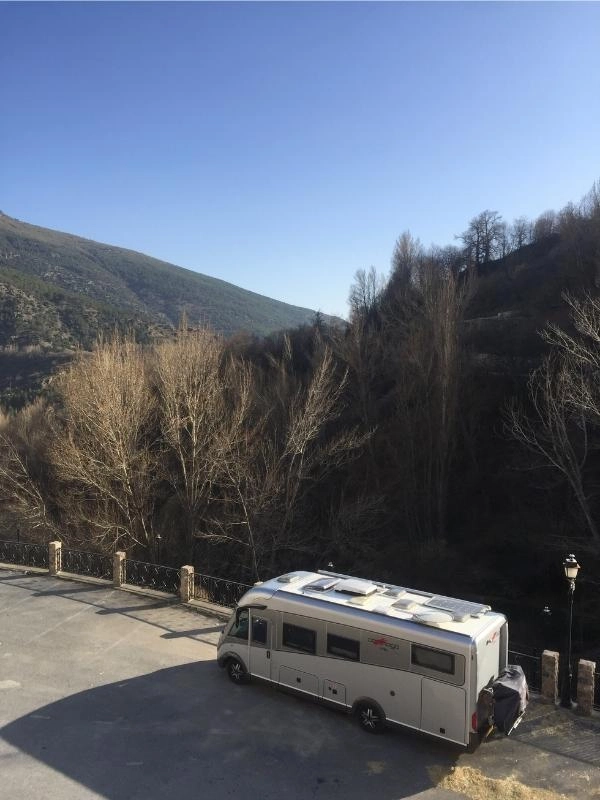
Almeria
Heading east, stop in the pretty and modern city of Almeria for an afternoon lunch along the promenade. Continue to the arid and wild Cabo de Gata National Park, 71,500 acres of protected land since 1987.
This is a fascinating and ecologically diverse part of Spain with over 80 species of birds living and breeding here.
Go out along the coast in a kayak, canoe or stand-up paddleboard if you can, and marvel at the crystal clear turquoise water, an abundance of sea life, wired rock formations and hidden sea caves.
Camping Los Escullos is a great site with an outdoor pool and fish and chip suppers in their restaurant on Fridays. Situated in the national park close to Los Escullos beach (a good spot for wild camping on the beach in Spain) and a couple of really good hikes, its a great spot and just a short walk from the beach and sea.
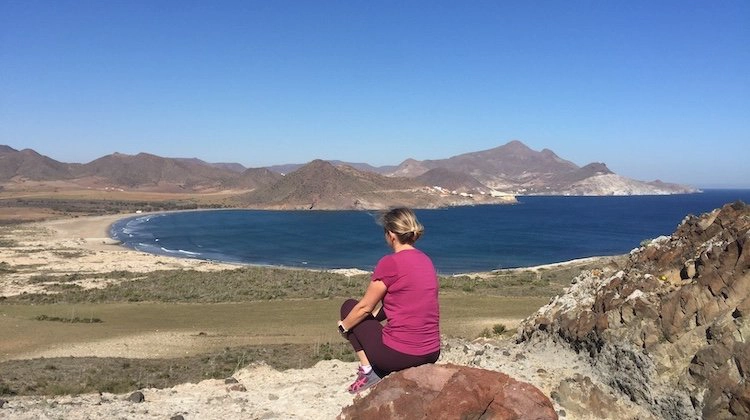
Cartagena
Cartagena is a city we really enjoy for its eclectic architecture and unexpected cosmopolitan feel. Founded by the Carthaginians around 220 BC, the city boomed during the Roman period.
Among its many Roman ruins are a 1st-century BC theatre and Casa de la Fortuna, a villa with murals and mosaics.
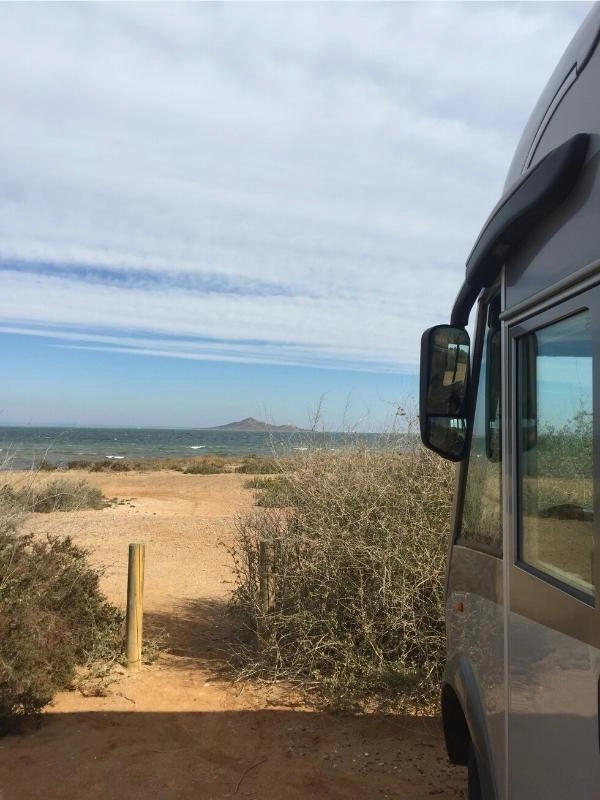
Costa Blanca
The Costa Blanca south of Denia, Javea and Calpe is another beautiful stretch of coast, with built-up areas of urbanizations, holiday villages and amusement parks. This area is popular with expats and motorhomers enjoying all that Spain has to offer, especially during the sunny days of winter.
The cities here are vibrant and busy even in winter, one of the main reasons for the large groups of motorhomers who gather to have a wonderful time in the winter sun. Alicante is a favourite destination, for its lovely old town and fantastic beaches along with its laid-back atmosphere, whilst neighbouring Benidorm is a real party city, with a lively expat and motorhome scene.
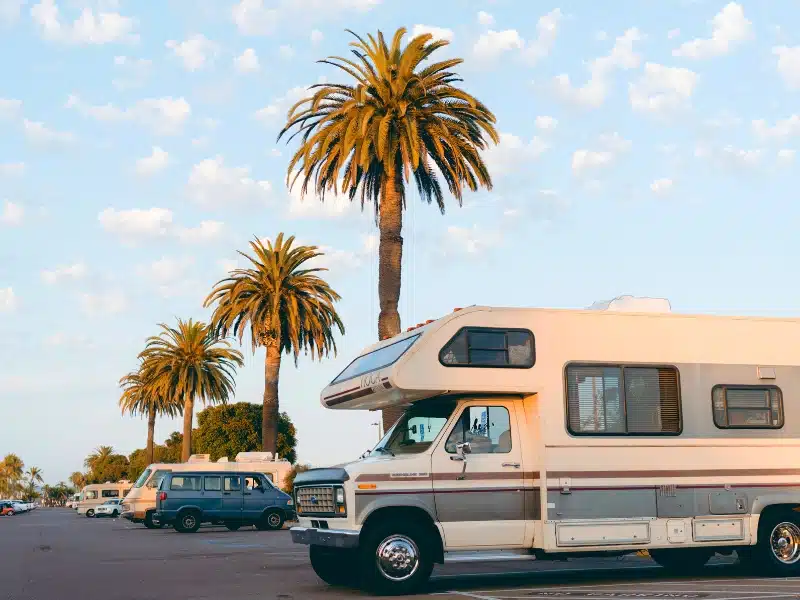
Valencia
Valencia is a green and vibrant city, with great nightlife and a beautiful Mediterranean climate. Visit the very modern science museum with contemporary architecture and wander the old river bed which runs right around the city.
If you’re feeling brave, go to Valencia during Las Fallas, the famous fire festival. The festival commemorates San José, the patron saint of carpenters and is held from 15th-20th March every year.
If you’re coming from the south, make sure to stop at the wetlands of La Albufera and try the traditional paella which originated here.
There is limited motorhome parking in Valencia, especially during the festival; we would suggest staying here.
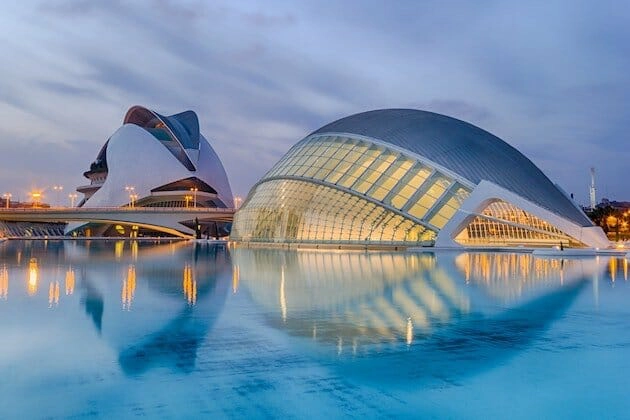
Serra d’Irta
Nestled between Alcossebre and Peniscola the tiny Serra d’Irta Natural Park is just 30 square miles large and is gorgeous for hiking with stunning sea views.
Stay at the lovely Camping Ribamar (although be aware that getting there requires a few km of unmade road) and hike into Peniscola along the coastal path.
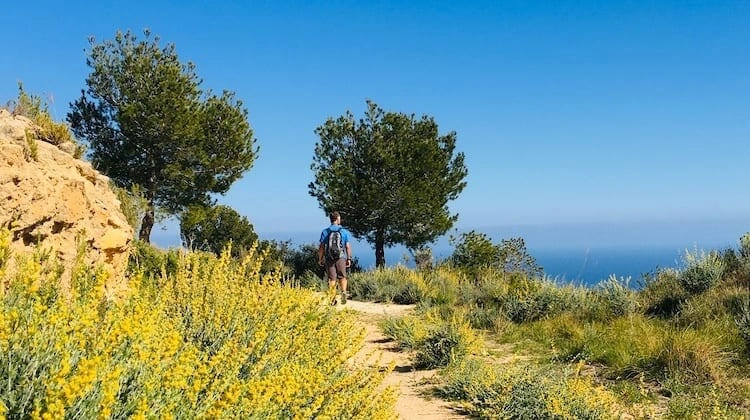
Parc Natural del Delta de l’Ebre
This tranquil and beautiful nature wetland nature reserve in the province of Tarragona is known for its birdlife and encompasses rivers, dunes & beaches. Nature lovers will enjoy find great hiking and bird-watching trails here.
Stay here on the north of the l’Encanyissada lagoon and if you’re lucky you’ll spot flamingoes migrating. On the way, stop at Sant Carles de la Rapita, a charming Spanish town with lots of great seafood restaurants.
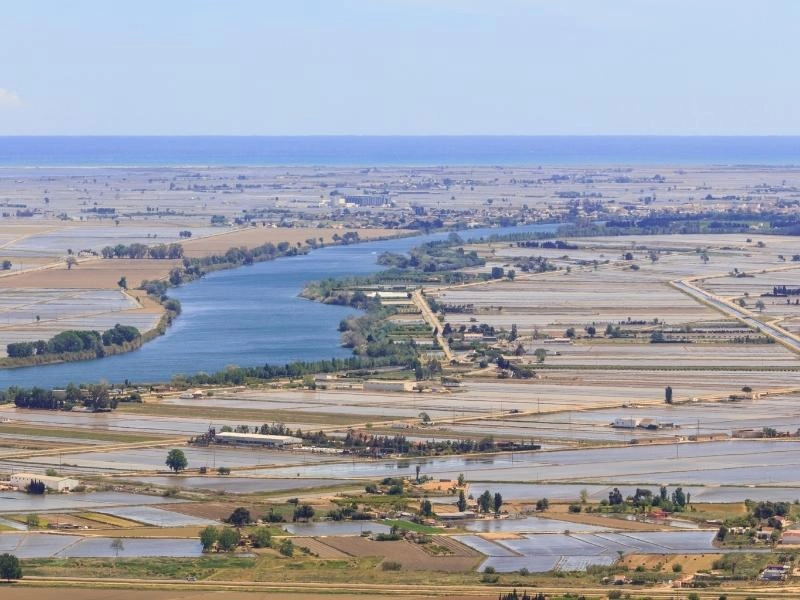
Barcelona
Continue north from here to the cosmopolitan and must-see city of Barcelona. With the fine beaches of the Costa Brava and a beautiful old town, this makes a great final stop on your motorhome tour of Spain. Barcelona is also a real cycling city, with over 160 miles of cycle paths, making it eay to camp on the outskirts and explore on two wheels.
Barcelona is a real foodie city, with a great central market and lots of fantastic tapas bars and seafood restaurants, check out the best restaurants in Barcelona for an authentic gastronomic experience when you visit the city.
Motorhome camping in and around Barcelona is challenging. Try your luck and risk a break-in at the free parking spots or try this campsite, which provides a reasonably priced shuttle into the city and is just ten minutes from the train station where you can catch a train into Barcelona with your bikes.
One Day in Barcelona – Itinerary, Map, Tips & Guide
Roses
Roses makes a good place for your first or final stop in Spain. Just 35km to the France-Spain border, Roses is both convenient and beautiful.
This is a great place to stop and gather yourself as you enter or leave Spain, and also offers the opportunity to explore the stunning nearby Cap de Creus, a wild and rugged peninsula and a headland. At certain times of the year vehicles are prohibited and you can only discover the area by hiking or cycling.
Stay at pretty Camping Rodas holiday park (only in summer, winter visito should camp here) and they’ll be able to let you know about restrictions on the road from Cadaqués and the Cap de Creus lighthouse. The site is also just a kilometre from the town centre and 300m from the beach, making it a great choice.
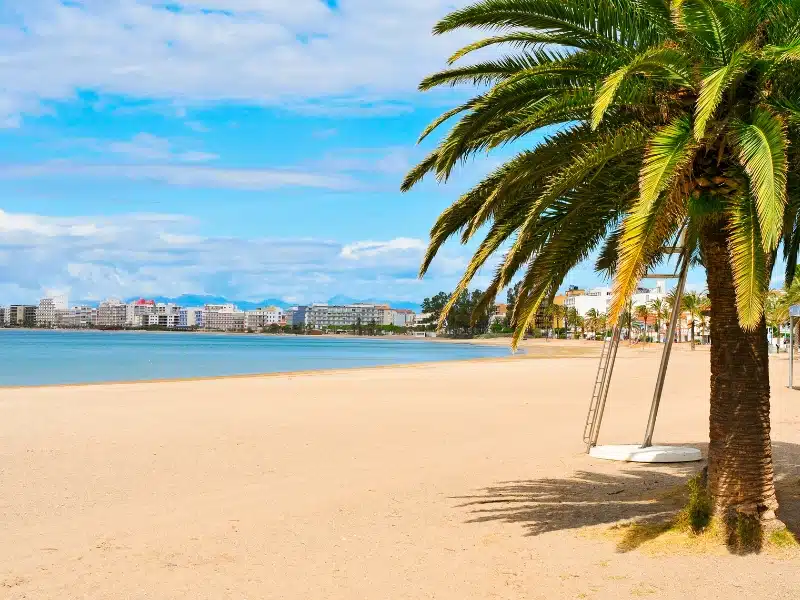
Can’t decide? Our ready-made Spanish road trips are here to help…
Spanish Life
Culture
Spanish life is all about family, religion, food and tradition. Spanish people live a more relaxed life than perhaps any other country in Europe and this is reflected in the organisation of the day. Our useful information and tips about life in Spain will help you navigate the differences between Spain and the UK.
- Spain has a number of different languages. Castilian (or Spanish) is the main language, with Catalan being spoken in Catalonia, Valenciano being spoken in Valencia (both being more like the French language), Galician belonging to the northern region and Basque belonging to the Basque Country. If you want to learn a few words, Castilian is the one to pick as it is the most widely spoken.
- Many businesses close between 12.30 or 1pm until 5pm and then open again until 8pm. This can vary a little from town to town but fundamentally the afternoon is for relaxing and spending time together as a family; if you can’t beat ’em, join ’em!
- Spain celebrates fourteen public holidays a year, many religious in origin; you can check out the dates here. There are a whopping 32 regional holidays, and every town and village has its own annual fiesta, religious in origin, but really all about the music, dancing and sometimes bullfighting. Some of these fiestas have become internationally recognised, such as La Tomatina in Bunol (yep, chucking tomatoes at each other) and Pamplona’s Festival of San Fermin (Running of the Bulls), and are incredibly popular with tourists. This guide has all the information you need.
- Sundays are truly sacred days in Spain. Many people will go to church but it is the extended family lunch, hosted by the matriarch, which is the most important part of the day. Very few, if any, shops are open on Sundays so it’s a good idea to make sure you’re stocked up!
- Following on from Sundays, many shops and restaurants will also close on Mondays with a sign on the door stating ‘cerrado por descanso del personal‘ (closed for the rest of the personnel). So make sure you stock up for Mondays too!
- Dog poo is a real issue across Spain. It looks horrible, smells disgusting and it’s a real bummer when you tread in it. Some towns are making real efforts to combat this issue (one traces the poo and posts it back….how??) but in others it seems to be accepted as the norm. You may find that that if you campervan Spain with a dog, the people are not as pet friendly as you are used to, and you’ll often see dogs tied up or confined within rural properties.
- Spanish people talk LOUDLY and over each other constantly. It is not a fight breaking out or a lover’s tiff, it’s just everyday conversation! How four people together all talking at the same time can ever take in what the other is saying is a mystery to me, but they seem to manage it!
- Spanish supermarkets are generally okay, all offering the basics and some a bit more upmarket, such as Carrefour. Mercadona, SuperCor and Eroski are similar in price and quality but do not carry the range of goods you would expect in a UK supermarket. Fruit and vegetables are seasonal; if you want something exotic you will have to search it out and it will be expensive. Lidl carries a good basic range and has by far the best-value wine in Spain. Lidl and Carrefour have great parking facilities for motorhomes, the others less so as they are often more centrally situated in towns.
- Spain is not as ‘finished’ as you might be used to. There are lots of failed projects around and many, many half-built houses and buildings. This is because of the financial crash in 2008 and the subsequent bursting of Spain’s property bubble.
- Whether you like it or not, bullfighting is a huge part of Spanish life and culture. Bullfighting is seen as heroic, a test of wills involving courage, intelligence, and elegance; matadors are national heroes. The bullfighting season runs from March to October with fights usually taking place on Sunday afternoons.
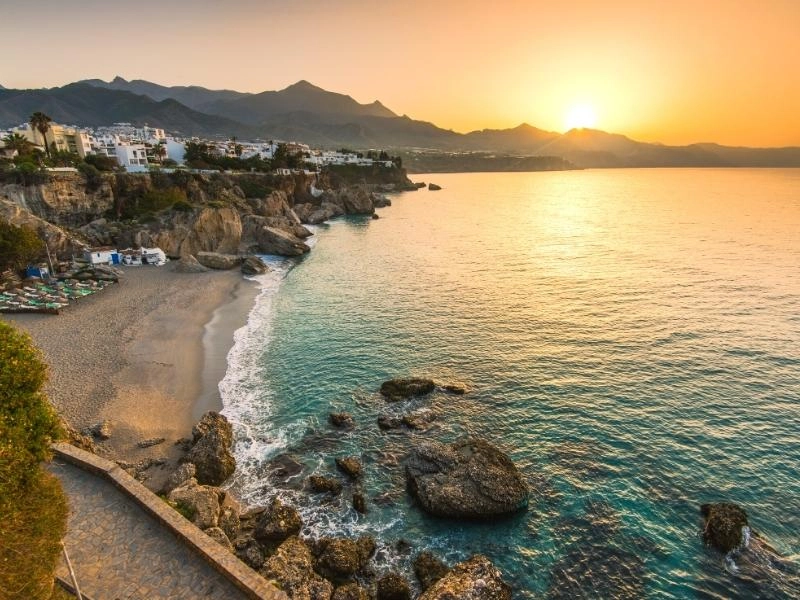
Food & Eating Out in Spain
Mealtimes are revered in Spain, as much about the time spent socialising at the table, as the food.
- Mealtimes in Spain are noticeably different to the rest of Europe. Lunch, which is the main meal of the day, is eaten between 2 and 3pm. Traditionally it was followed by a nap, the famous siesta, a sacred art in rural Spain. Walk around any Spanish village or town in the early afternoon and you will clearly hear the sounds of cutlery on crockery, amid laughter and loud chatter as families lunch together.
- Spain is one of the cheapest countries to visit in Europe and it’s possible to eat out on a budget. Many restaurants will serve a menu del dia or menu of the day. These are usually exceptionally good value and will give you a taste of the local and seasonal flavour and cooking style. Try a dish like berenjenas rellenas (stuffed aubergine) when this Mediterranean vegetable is in season and you’ll be blown away. Service is usually included in the fixed price, which can range from €10 to €18 or possibly more if you’re in a big tourist city.
- La cena (dinner or supper), a lighter meal, is also taken late, between 9 and 10pm, or even later during the hot summer months. Often restaurants will not open their doors until 8pm, this is considered early!
- Tapas is famous in Spain; traditionally it was an appetiser and a small portion of anything on the menu. Like all good things, tapas has evolved and can now be combined to make a whole meal. In some bars, you will get a bowl of pattatas bravas or tortilla with your drink; these portions can be large and we have been known not to finish our meal because of too much beer and tortilla!
- Desayuno (breakfast) is simple and usually sweet. Hot chocolate with churros is a favourite, the chocolate thick gloop and the churros freshly cooked. The Spanish have even invented a takeaway cone with a cup holder for chocolate y churros!
- Spanish cooking is very regional, with fish, shellfish and pork featuring heavily on most menus. Vegetarian or vegan food can be hard to find outside of bigger towns and cities. Often ‘vegetarian’ means made from vegetables, not vegetarian in the true sense of the word. You might get parmesan cheese in a ‘vegetarian’ dish for example, or prawns in a ‘vegetarian’ salad. If in doubt, double check with the chef or waiting staff.
- If you’re planning on dinner, expect the restaurant to be quiet and soulless before 9pm. If you’re going later and you’re in a popular town or city, expect to wait for a table or book.
- Unless you are in an absolute dive or the service is dreadful, it is expected that you will leave a tip, usually around 5%.
- If you are ordering a chicken dish in Spain, be very careful with your pronunciation of pollo. If you ask for polla, it is unlikely to be served to you as it’s the Spanish word for penis!
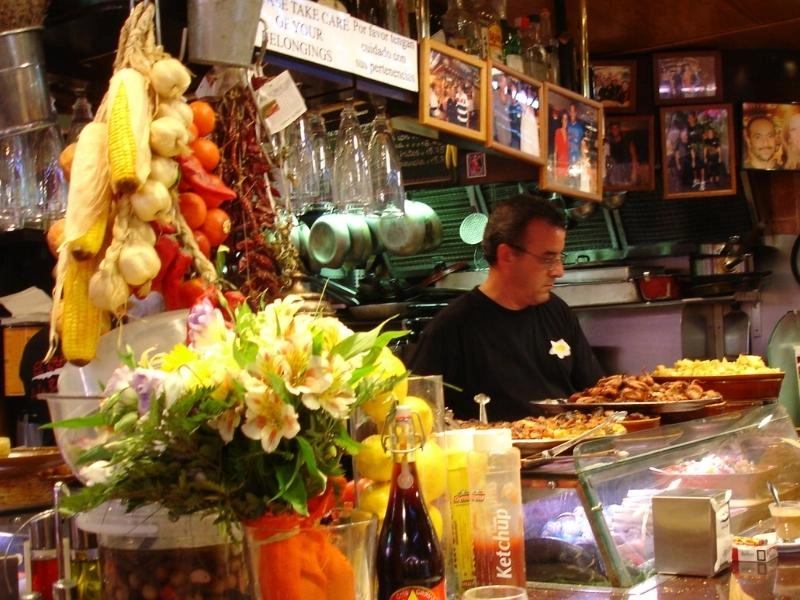
Are you looking for more motorhome touring guides? Check out these top posts…
Motorhoming in France: Your Complete Touring Guide for 2024
Motorhoming in Italy: Your Complete 2024 Guide
Planning Your Morocco Motorhome Adventure
Campervanning in Portugal: Complete Guide for 2024
Campervanning in Norway: Tips, Routes & Destinations for 2024
Motorhoming in Germany: Your Complete Touring Guide for 2024
Love it? Pin it!
